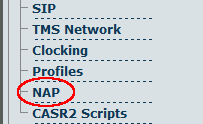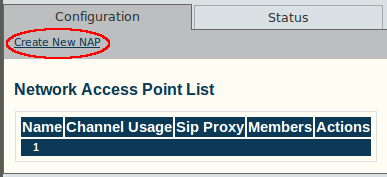Toolpack:Creating a CAS R2 NAP A
From TBwiki
(Difference between revisions)
(add channel usage for CASR2) |
|||
| Line 32: | Line 32: | ||
* Select an '''interface''' (the newly-created '''CAS R2 stack''') | * Select an '''interface''' (the newly-created '''CAS R2 stack''') | ||
* Click the '''"<<"''' button to add the interface to the list | * Click the '''"<<"''' button to add the interface to the list | ||
| + | * Select a value for [[Parameter:_Channel_Usage|'''Channel Usage''']], to avoid call collision | ||
[[Image:Toolpack_v2.5_NAP_CASR2.png]] | [[Image:Toolpack_v2.5_NAP_CASR2.png]] | ||
| Line 48: | Line 49: | ||
* [[Parameter: Name|Name]] | * [[Parameter: Name|Name]] | ||
* [[Parameter: Default Profile|Default Profile]] | * [[Parameter: Default Profile|Default Profile]] | ||
| + | *[[Parameter: Channel Usage|Channel Usage]] | ||
Revision as of 15:29, 13 December 2012
Applies to version(s): v2.5, v2.6.
Now that you have created a CAS R2 stack, you must create a network access point, in order to finish configuring your system. A Network Access Point (NAP) represents the entry point to another network or destination peer.
To create a network access point (NAP):
1- Click NAP in the navigation panel
2- Click Create New NAP
3- Configure the new NAP:
- Enter a name for the NAP
- Select a user-created profile, if not, select default
- Click Create
4- Verify that the NAP was successfully created message appears
5- Associate a CAS R2 stack with the NAP:
- Select an interface (the newly-created CAS R2 stack)
- Click the "<<" button to add the interface to the list
- Select a value for Channel Usage, to avoid call collision
- Click Save
6- Verify that the "NAP was successfully updated" message appears



